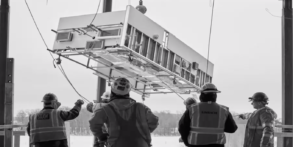
Yes, Modular Building took some lumps in 2020. September brought the news that Chicago-based, Skender, would shutter its modular plant after a much publicized grand opening just the year earlier, and, just last week came reports by the Wall Street Journal that Softbank would be “bailing out” Katerra, the industry’s highest flying modular builder with a $200 million investment and accompanying dilution and debt cancellation. So, is modular construction’s run over? We don’t believe so. Despite well publicized setbacks such as those experienced with Skender and Katerra, modular building efforts are garnering serious investment from sophisticated players (more on that in a follow-up Briefing), identifying new business models for the approach and carving out successful niches.
Modularization is More a Technique, than a Product or a Company
Modular Building is a way of building, what people in the industry also call “means and methods.” Modular approaches can be applied to many aspects of buildings and infrastructure projects, from HVAC, piping and mechanical pre-assemblies to walls (as we saw in last fall’s presentations pictured above) and bathrooms to entire buildings. We have even heard reports of modularized Covid-friendly dining pavilions. Modular Builders are also working across many different sectors of the built environment, including single family residential, multi-family residential, hotels and dorms, and industrial and infrastructure projects. A recent report celebrated that fact that the new Tesla plant in Texas would use unspecified modular techniques. The concept has been applied in many circumstances for ages. Its benefits are well documented, and it is a technique that does no appear to be going away.
Speaking of Tesla, Maybe Electric Cars Offer A Good Comparison Point
Anybody remember the Fisker Bankruptcy back in 2013? Back then, news came that the US Government would lose much of its $529 billion investment in electric car maker, Fisker Automotive. Beyond Fisker, there have been a host of other bankruptcies in electric car market in the past decade. Despite those troubles, according to a report by Deloitte in partnership with IHS Markit, EV sales have already grown to 2.5 million units in 2020 and are projected to grow to 31.1 million units by 2030. According to the report, the electric car market share will grow to 25% of the US market and more than 40% of the Chinese market by 2030. So, where might that leave Softbank? Well, we don’t make predictions about specific companies. However, today, Tesla (TSLA) hit a market capitalization of more than $700 billion on news it had shipped nearly 500,000 electric vehicles last year. So, if the analogy holds, there may yet be significant opportunity for modular building companies.
So Where Does All of This Leave Modularization?
Much like the electric vehicle market, which is now seeing the emergence of a whole ecosystem of valuable companies, specializing in different types of vehicles, electric vehicle components and systems, and even the the required associated infrastructure of charging stations, we believe we will continue to see the growth of a modular building ecosystem of companies specializing in different types of buildings and infrastructure, components, software, and associated infrastructure. There is just too much potential in modular techniques as a fundamental ingredient in the effort to tackle the cost, quality, and other challenges facing the industry.
ABOUT BUILTWORLDS BRIEFINGS:
BuiltWorlds Briefings offer the BuiltWorlds Community perspectives on news affecting the community, opportunities to learn about network members, and also information about programming, research and other activities within the BuiltWorlds Member Network and broader BuiltWorlds Free Subscriber community. BuiltWorld Analyst Briefing are made possible through the support of the members of the BuiltWorlds Network.
ABOUT BUILTWORLDS:
BuiltWorlds is the buildings and infrastructure industry’s leading professional network for open innovation, keeping companies in the worlds of engineering, construction and related fields informed and connected, and helping them find avenues to collaborate for their own strategic success and for the betterment of the industry, as whole. For more information about BuiltWorlds, visit the BuiltWorlds Network or sign up for the BuiltWorlds Newsletter to stay connected to the Community for free.


Discussion
Be the first to leave a comment.
You must be a member of the BuiltWorlds community to join the discussion.